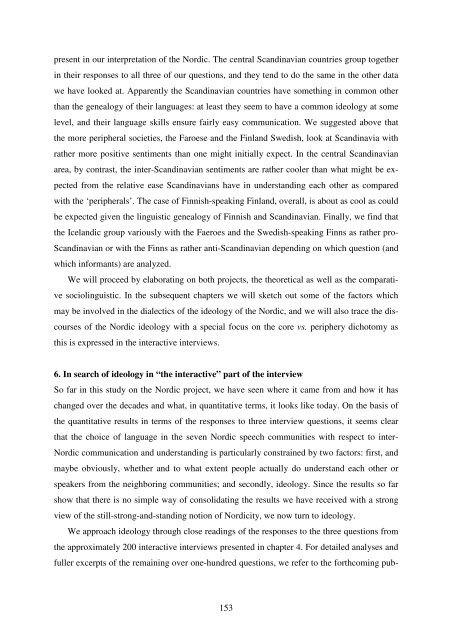Hør dog hvad de siger - Note-to-Self: Trials & Errors
Hør dog hvad de siger - Note-to-Self: Trials & Errors
Hør dog hvad de siger - Note-to-Self: Trials & Errors
Create successful ePaper yourself
Turn your PDF publications into a flip-book with our unique Google optimized e-Paper software.
present in our interpretation of the Nordic. The central Scandinavian countries group <strong>to</strong>gether<br />
in their responses <strong>to</strong> all three of our questions, and they tend <strong>to</strong> do the same in the other data<br />
we have looked at. Apparently the Scandinavian countries have something in common other<br />
than the genealogy of their languages: at least they seem <strong>to</strong> have a common i<strong>de</strong>ology at some<br />
level, and their language skills ensure fairly easy communication. We suggested above that<br />
the more peripheral societies, the Faroese and the Finland Swedish, look at Scandinavia with<br />
rather more positive sentiments than one might initially expect. In the central Scandinavian<br />
area, by contrast, the inter-Scandinavian sentiments are rather cooler than what might be ex-<br />
pected from the relative ease Scandinavians have in un<strong>de</strong>rstanding each other as compared<br />
with the ‘peripherals’. The case of Finnish-speaking Finland, overall, is about as cool as could<br />
be expected given the linguistic genealogy of Finnish and Scandinavian. Finally, we find that<br />
the Icelandic group variously with the Faeroes and the Swedish-speaking Finns as rather pro-<br />
Scandinavian or with the Finns as rather anti-Scandinavian <strong>de</strong>pending on which question (and<br />
which informants) are analyzed.<br />
We will proceed by elaborating on both projects, the theoretical as well as the comparati-<br />
ve sociolinguistic. In the subsequent chapters we will sketch out some of the fac<strong>to</strong>rs which<br />
may be involved in the dialectics of the i<strong>de</strong>ology of the Nordic, and we will also trace the dis-<br />
courses of the Nordic i<strong>de</strong>ology with a special focus on the core vs. periphery dicho<strong>to</strong>my as<br />
this is expressed in the interactive interviews.<br />
6. In search of i<strong>de</strong>ology in “the interactive” part of the interview<br />
So far in this study on the Nordic project, we have seen where it came from and how it has<br />
changed over the <strong>de</strong>ca<strong>de</strong>s and what, in quantitative terms, it looks like <strong>to</strong>day. On the basis of<br />
the quantitative results in terms of the responses <strong>to</strong> three interview questions, it seems clear<br />
that the choice of language in the seven Nordic speech communities with respect <strong>to</strong> inter-<br />
Nordic communication and un<strong>de</strong>rstanding is particularly constrained by two fac<strong>to</strong>rs: first, and<br />
maybe obviously, whether and <strong>to</strong> what extent people actually do un<strong>de</strong>rstand each other or<br />
speakers from the neighboring communities; and secondly, i<strong>de</strong>ology. Since the results so far<br />
show that there is no simple way of consolidating the results we have received with a strong<br />
view of the still-strong-and-standing notion of Nordicity, we now turn <strong>to</strong> i<strong>de</strong>ology.<br />
We approach i<strong>de</strong>ology through close readings of the responses <strong>to</strong> the three questions from<br />
the approximately 200 interactive interviews presented in chapter 4. For <strong>de</strong>tailed analyses and<br />
fuller excerpts of the remaining over one-hundred questions, we refer <strong>to</strong> the forthcoming pub-<br />
153



